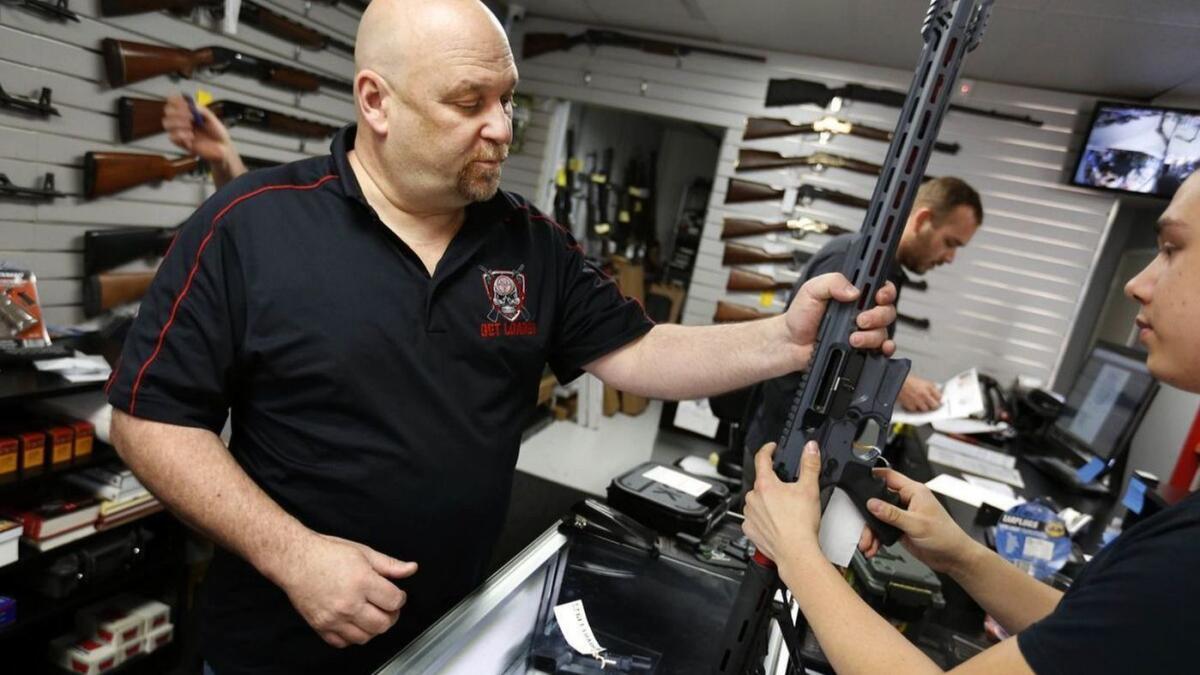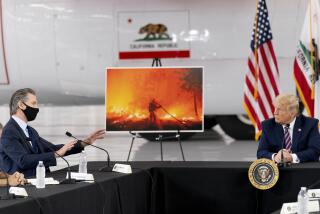Gov. Gavin Newsom makes aggressive, early moves on his gun control agenda for California

- Share via
Reporting from Sacramento — Gavin Newsom won the governorship in part by touting his leadership on gun control as the architect of Proposition 63, a 2016 initiative that put him at loggerheads with the National Rifle Assn.
Now, in his first weeks in office, Newsom has already moved to significantly reduce the number of Californians with firearms.
Gun rights advocates are sounding almost nostalgic for his predecessor, fellow Democrat Jerry Brown, a gun owner who signed several far-reaching gun control measures, including a ban on the sale of long guns to those under age 21, but vetoed others.
“Gavin Newsom has demonstrated he has little to no understanding of firearms and firearms policy,” said Craig J. DeLuz, a spokesman for the Firearms Policy Coalition, which has opposed many gun bills. “For him this is a PR issue, meaning he will probably sign whatever is put in front of him. He wants to run for president.”
In his state budget plan released days after he took the oath of office, Newsom proposed adding $5.6 million — about 50% more than in Brown’s budget this year — to seize guns from thousands more people who are ineligible to possess firearms because of criminal convictions or mental illness.
The governor is also asking lawmakers to beef up a California Department of Justice unit responsible for enforcing laws on gun sales. And his budget also proposes more money for the Firearms Violence Research Center at UC Davis.
At the same time, state lawmakers have cited Newsom’s aggressive stance on gun control in reintroducing bills that were vetoed by Brown.
Newsom made it clear that the issue would be a priority in his Jan. 7 inaugural speech, when he said “there are powerful forces arrayed against us,” including “a gun lobby willing to sacrifice the lives of our children to line their pockets.”
The gun-seizure program has been underfunded in the past, resulting in a backlog of some 10,000 people who bought firearms but were later charged and convicted of a felony or found to have a serious mental illness that disqualifies them from being armed.
The additional money to seize firearms is “aimed at addressing longstanding issues” with the gun-confiscation effort, said Jesse Melgar, a spokesman for Newsom, who added, “as governor, he will continue to be a loud voice for common-sense gun safety.”
Newsom was the official proponent in 2016 of Proposition 63, an initiative that outlawed large ammunition magazines, mandated background checks for those who buy bullets and levied fines for failing to report when guns are stolen or lost. It also created a process for taking guns away from people when they are convicted of a felony, which puts them in the state’s Armed Prohibited Persons System.
The system matches the names of gun buyers to a list of those who later become ineligible to own firearms because of a criminal conviction, a court judgment of serious mental illness or being subject to a domestic violence restraining order. But it currently has a backlog that could be eliminated of some 10,000 people if lawmakers approve Newsom’s budget request this spring. The plan would increase resources for seizing guns from those on the list, from $11.8 million to almost $17 million, allowing the state DOJ to remove guns from about 4,500 additional people.
Newsom’s budget also proposes a way to save the program from a pending legal challenge that argues the system is improperly funded with fees from gun purchasers — paying for it out of the state’s general fund.
The additional funding is “significant” and “desperately needed,” said Amanda Wilcox, a leader of the California Chapters of the Brady Campaign to Prevent Gun Violence. Wilcox, who lost a daughter to gun violence, sees the budget increase as a sign that Newsom will also sign a series of recently proposed gun bills if they reach his desk later this year.
“We know that Gov. Newsom shares our key goal of keeping dangerous weapons out of dangerous hands and we anticipate his support of our package of gun bills this year,” she said.
Newsom clashed again with the NRA this week over a lawsuit that has blocked part of Proposition 63 — the ban on high-capacity ammunition magazines. The NRA’s California affiliate persuaded a federal judge in 2017 to prevent it from taking effect, and an appeals court upheld the preliminary injunction in July.
A ruling on the merits of the law is expected any day, said Sean Brady, an attorney who represents the California Rifle and Pistol Assn. in the case.
“The NRA is doing everything in its power to overturn the will of the people,” Newsom said in a social media post this week. “Californians took first-in-the-nation actions against gun violence, and we’ll keep doing what it takes to keep our families and communities safe.”
In arguing for more action on guns, Newsom has cited a string of mass shootings, including the 2016 terrorist attack in San Bernardino that left 14 dead and 24 injured, and last year’s massacre at a high school in Parkland, Fla., that claimed the lives of 17 students and employees.
The focus on gun control was heightened the day after Newsom was elected in November when a gunman killed 12 people at the Borderline Bar and Grill in Thousand Oaks. One day later Newsom promised action, saying California “can do more and do better on gun safety,” and indicated he is open to signing bills that had been vetoed in the past.
Two days after Newsom’s comments, Assemblyman Phil Ting (D-San Francisco) reintroduced a bill that had been vetoed by Brown to allow teachers, employers and co-workers to seek court orders temporarily removing guns from people thought to be a danger to themselves or others.
Brown said in his veto message that the Ting bill was not necessary because state law already gives law enforcement and family members authority to seek a gun violence restraining order. But Ting said others are also in a position to identify dangerous gun owners, and Newsom’s election gives him new optimism.
“The governor has expressed interest in doing more on gun safety than the previous administration, and we’re hopeful he takes a second look at our proposal,” Ting said.
Newsom’s election has given similar hope to state Sen. Anthony Portantino (D-La Cañada Flintridge), who has re-introduced a measure vetoed by Brown that would limit Californians to buying no more than one rifle or shotgun a month.
Brown vetoed similar bills, including in 2015 when he said, “Given California’s stringent laws restricting gun ownership, I do not believe this additional restriction is needed.”
Portantino said his revived proposal is needed to prevent straw purchases, in which an eligible owner buys many guns and then sells them to people not authorized to possess firearms. In one recent year, sales to individuals ranging from five to 54 long guns per month occurred on 1,787 occasions — totaling 12,090 guns, he said.
“California may be a Western state, but it’s no longer the Wild West,” Portantino said. “A person shouldn’t be able to walk into a gun store and come out with an arsenal. This issue was just too important to not give it a fresh try with a new governor in office.”
Coverage of California politics »
Twitter: @mcgreevy99
More to Read
Get the L.A. Times Politics newsletter
Deeply reported insights into legislation, politics and policy from Sacramento, Washington and beyond. In your inbox three times per week.
You may occasionally receive promotional content from the Los Angeles Times.











